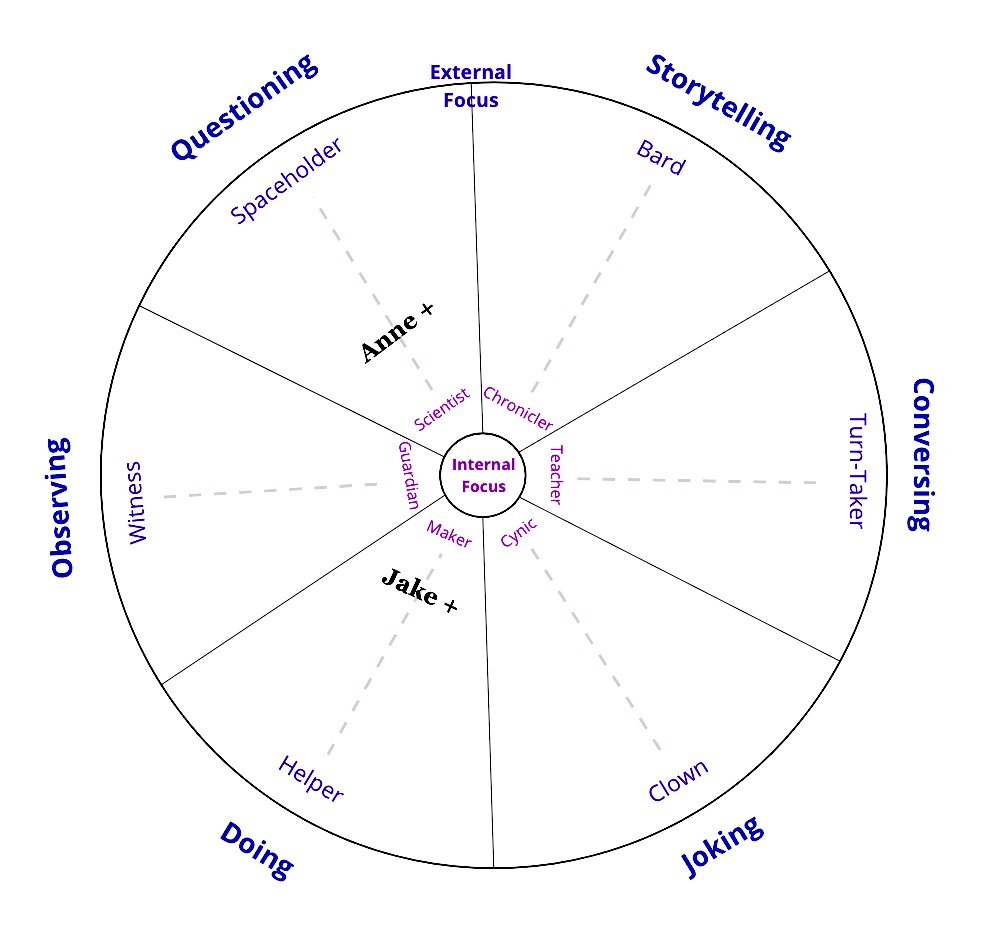The Relating Languages Part 2: Stress and Safety in Connection
Apr 07, 2021
by Sara Ness
Why is it that sometimes we can be our “best selves” — grounded, connected, and aware — and sometimes, we’re a total relational mess?
Personality typing systems give us a general concept of who we are. I’m an “Enneagram 7” — enthusiastic, scattered, and adventuresome. I’m an “ENFP” — extroverted, intuitive, feeling, and prospecting. These systems have helped me understand myself, but they sometimes break down in relationship to other humans. Then, I seem to be not one type but many.
Why do I sometimes feel extroverted, and other times want to hide? Why am I intuitive when I feel clear on my role, and totally blocked when the situation feels chaotic or unclear?
I think we need a new system to complement those we have. A system that deals specifically with communication types, and how they change, and how they interact. A system that I call the Relating Languages.
In this article, I’ll talk about a specific aspect of the Languages: how you change which one you’re using depending on your subjective perception of Stress and Safety. Different Situations can also cause type-changes, but we’ll talk about that in a future article.
Here’s an overview of the Relating Languages. Each type has two Dialects that lie on a spectrum between internally- and externally-focused, moving from left to right (for example, the Chronicler is more internally-focused and the Bard more externally-focused).
To make this more readable, I’ve put the Languages I’ll be referencing in this article in bold.
The Relating Languages


How do they work in practice?
Conflict in Connection
My friends Jake and Anne have been struggling in their relationship. Normally, they’re great friends. Anne is naturally curious about everything. In Relating Languages terminology, we’d call her a Scientist, the internally-focused Questioning type: she asks in order to understand the world and test her theories about it.
This fits well with Jake, who likes creating things. He’ll dive deep into a particular fascination, which Anne will enjoy asking about. We’d call him a Maker, which is the internally-focused Doing-type.
The problem comes when Jake and Anne fight. Jake, who is very private about his emotions, turns spiky and cold in his communication. His comments have an edge; he’s sarcastic, dismissive, and withdrawn. He becomes a Cynic — the more internally-focused of the Joking types.
Anne responds by trying to make it all better. Her curiosity becomes focused towards what she can do to assist. She makes offers and apologies, and extends herself into Jake’s emotional space to reach him. Under stress, Anne becomes a Helper, the externally-focused Doing type.
This extension makes Jake pull away even further. He throws verbal barbs in Anne’s direction to keep her at a distance. Unprotected, with all her attention out towards Jake, Anne gets very hurt. She blames him, but she can’t help continuing to try and make it better.
Why do Anne and Jake change their communication when they’re stressed? And what can they do about it?
Stress, Safety, and Spectrums
In Relating Languages, each type contains a spectrum of attention. At one side of the spectrum, communicators tend to have their attention inside themselves while in connection. This is the internally-focused Dialect of the language. At the other end, communicators have their attention focused outwards onto the other. This is the externally-focused Dialect of the language. Most people fall somewhere between the ends in their communication, which is why this is a spectrum.
Neither end of the spectrum is “better” or “worse”. Both have situational uses. However, it’s a great thing to have flexibility along the spectrum, because some situations call for attention out, and others, for attention in.
When Jake and Anne feel comfortable with each other, they are both more internally-oriented types. Anne is balanced a little more towards the middle of the spectrum than Jake is — she has some qualities of the Spaceholder with Jake, because she cares a lot about him.
But, Anne is predominately a Scientist when she feels safe with Jake. In fact, she is a Scientist around most people and situations she feels comfortable with, including herself when she feels good inside. We would call Scientist her Safety type. Jake’s Safety type is the Maker.

When this couple is stressed, they polarize towards types on opposite ends of the spectrum. Anne extends out; Jake contracts in. Neither has much freedom towards the middle. They adopt their Stress types: Helper for Anne, Cynic for Jake. *

Now we see why Jake and Anne are having such problems. They are used to a certain form of connection, but when they’re upset, their relating styles totally change. They lead with a different form of communication, and in Anne’s case, the locus of her attention changes from inside to outside of herself.
No wonder their conflicts are so intense! Any strategies they practice while in a space of safety won’t work, because they are literally different communicators under stress.
What To Do?
Anne talked to me about her difficulties with Jake. I thought about it for a while, and then made a suggestion.
“Jake seems like a pretty internally-focused person, whether he feels safe or stressed. You also keep a lot of your attention inside yourself when you feel safe. You love gathering information about the world and bringing it back to yourself, even spending time alone to process it.
“But, when you’re stressed, you go outside yourself. You get into Jake’s space. You try to help him, when the last thing he wants is contact or help. I mean, I imagine he does want those things, but he can’t stand them in the moment. Does that feel true?”
Anne nodded. I continued,
“Okay, then. What do you think would happen if you held onto your safety-type while Jake was under stress? If you kept your attention inside yourself, not getting into Jake’s space, and then asked him questions - not to help him, but just to understand? The same way you do when you feel comfortable together.”
Anne lit up. She said, “I’ve done that a few times, and it worked great. I’ll try it on more often!”
Like I told Anne, one technique she could use in this space is to adopt her Safety type even under stress. She could, in fact, try on any of the internally-focused types, such as the Storytelling Chronicler or the Conversational Teacher; but given that she already knows the form of the Scientist, it will likely be the easiest for her to adopt.
If Jake were willing to help resolve the conflict, he could certainly withdraw into his Safety-type Maker, but that would likely mean going away to work on something and leaving Anne hanging (it wouldn’t make sense, in the moment, to start talking about a project that fascinated him).
If Jake wanted to meet Anne where she is, he’d have to try on a more externally-focused type. He could start asking her nonjudgmental questions about her upset (the Spaceholder), openly telling her what’s going on for him (the Bard), or calming down enough to observe the situation and only speak when something feels alive (the Witness).
Either of them could also choose the time-tested strategy of Taking a Break For a While. They could get resourced by themselves or other friends in that space, and come back when they feel safer internally.
* Those familiar with attachment theory may be able to draw some parallels to the internal/external balance of RL Dialects. I am reticent to suggest this without more research, but it is possible that internally-focused dialects tend to portray avoidantly-attached traits, while externally-focused ones portray anxiously-attached traits. This may explain why so many people experience a disorganized attachment style; if they switch between internal and external in stress and safety, their attachment needs would actually change in relationship to the other person.
For example, when Anne and Jake are in their Safety types, they are relatively matched in levels of avoidance. When they go into their Stress types, Anne becomes anxious, and Jake remains avoidant. This switch in attachment needs confuses them both, and they often require a separation for days or even weeks before Anne’s anxiety fades and Jake can extend again.
Try It On
Take a look again at the diagram at the top of this article, or read Part 1 of the Relating Languages series to get a brief overview of the types (at bottom of that article). What type of communication do you adopt when you feel safe? What do you speak when you feel stressed? How does that interact with the communication of the people closest to you?
Try some experiments over the next few weeks. See if you can play with stress and safety, internal or external focus, and what that does to your relationships. And please, let me know how it goes!!
— — — —
This is Article 2 of a series on the new communication typology Relating Languages, developed by Sara Ness of Authentic Revolution. Find Article 1 here.
Relating Languages is a theory still under development. You can contact the author at [email protected] with thoughts, questions, or offers of assistance. Sign up here to get updates as I develop this theory and book. Thanks for reading!
Image: “Fear”, by Cecilé Carre
Lorem ipsum dolor sit amet, consectetur adipiscing elit. Cras sed sapien quam. Sed dapibus est id enim facilisis, at posuere turpis adipiscing. Quisque sit amet dui dui.
Stay connected with news and updates!
Join our mailing list to receive the latest news and updates from our team.
Don't worry, your information will not be shared.
We hate SPAM. We will never sell your information, for any reason.

